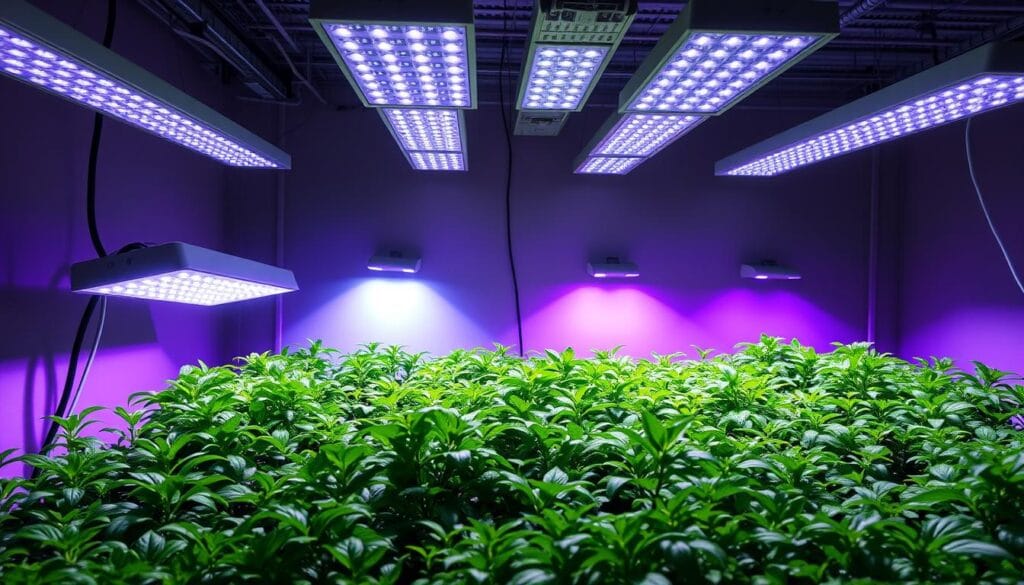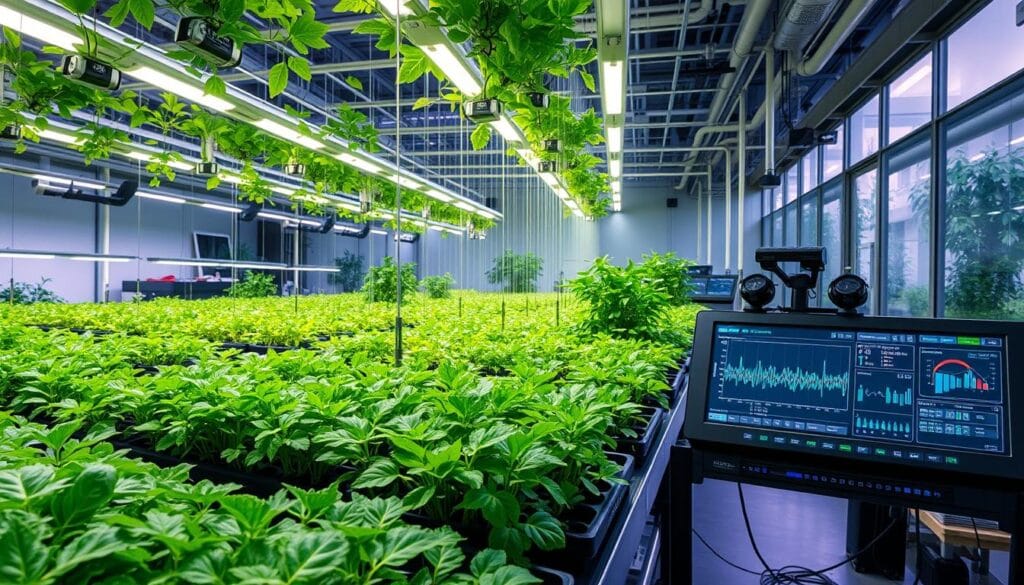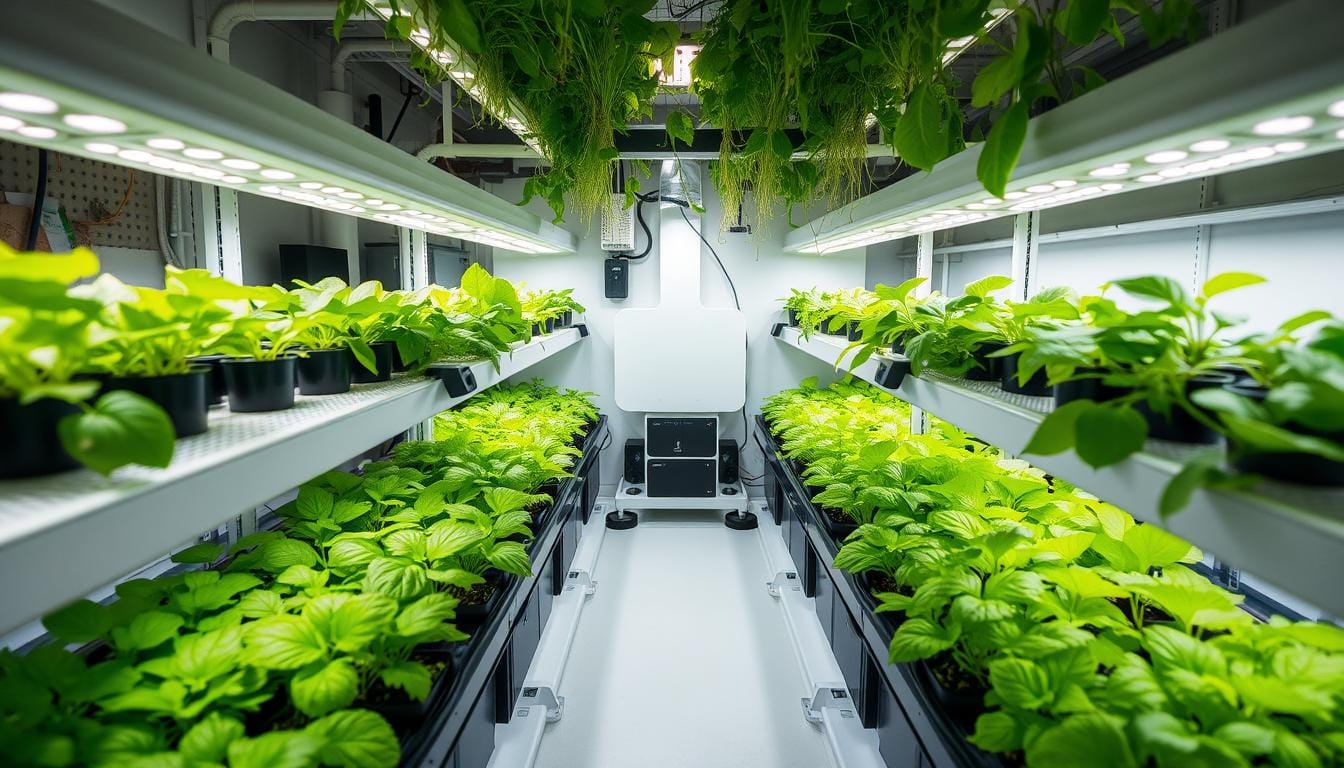As the sun rises over the greenhouse, I feel excitement and anticipation. For over a decade, I’ve worked on perfecting commercial hydroponic system design. I’m passionate about helping growers like you reach the full potential of controlled environment agriculture (CEA). Today, I’m excited to share strategies and insights that have helped many businesses in optimizing hydroponic systems to achieve maximum efficiency and growth.
Hydroponic systems have changed modern agriculture, offering a more efficient and sustainable way to grow crops. Whether you’re a seasoned grower or new to CEA, planning and optimizing your hydroponic system can be thrilling and challenging. But don’t worry, with the right guidance, you can confidently navigate this journey and set your business up for success.
Key Takeaways
- Understand the comprehensive project development process for commercial hydroponic systems, from pre-design to operations.
- Recognize the importance of personalized water management planning, including site analysis and water quality assessment.
- Explore the essential components of modern hydroponic systems, such as schematic design, system design development, and construction documents.
- Discover strategies for optimizing water efficiency, reducing costs, and promoting sustainable water management practices.
- Leverage the expertise of experienced professionals to ensure the success of your commercial hydroponic operation.
Understanding Commercial Hydroponic System Fundamentals
Commercial hydroponic systems are changing the way we grow food. They use water, nutrients, and controlled spaces to grow plants better. Learning about these methods and parts can help your business grow.
Types of Hydroponic Growing Methods
There are many ways to use hydroponics for growing crops. Each method has its own benefits. Here are a few:
- Drip systems: Give plants a steady flow of nutrients.
- Nutrient Film Technique (NFT): Keeps roots wet with a thin layer of solution.
- Deep Water Culture (DWC): Roots float in a nutrient-rich solution.
- Aeroponics: Roots get a fine spray of nutrients.
- Ebb and Flow: Plants get water and then rest.
Essential Components of Modern Hydroponic Systems
Good hydroponic systems need a few key parts. These parts help plants grow well. They include:
- Growing media: Stuff like rockwool helps roots grow.
- Nutrient solution: A mix of nutrients that plants need.
- Water delivery system: Makes sure plants get enough water.
- Environmental controls: Keeps things like temperature and humidity just right.
Scale Considerations for Commercial Operations
When growing hydroponically on a big scale, things get more complex. You need to think about design, automation, and using new tech. This helps grow plants better and faster, meeting demand.
“Hydroponic systems offer unparalleled control over the growing environment, allowing us to push the boundaries of what’s possible in commercial agriculture.”
Knowing how hydroponics work opens up new chances for growers. It means better growth, less waste, and crops all year. Keeping up with new ideas and methods is key to success in today’s farming world.
Hydroponic System Optimization for Maximum Yield
To get the most from your setup, optimizing hydroponic systems with a detailed plan is essential. The right lighting is key for good production; without enough light, plants grow weak and struggle to absorb nutrients effectively.
Lighting directly affects plant growth. Plants rely on blue and red light most for photosynthesis, so knowing the optimal lighting for your plants is crucial for their health and growth.
Keeping the pH level (5.5 to 6.5) and dissolved oxygen (5-7 ppm) right is also crucial. The right nutrient solution management is important too. Adjusting nutrients for each growth stage can help plants perform better.
| Nutrient | Optimal pH Range |
|---|---|
| Nitrogen (N) | 6.0 – 7.0 |
| Phosphorus (P) | 6.5 – 7.5 |
| Potassium (K) | 5.5 – 7.5 |
By focusing on lighting, pH control, and nutrient management, you can get the best from your hydroponic system. Keeping an eye on these factors helps your plants grow strong and produce lots of food.
“Proper hydroponic system optimization is the key to unlocking the true potential of your crops and maximizing yield.”
Water Management and Quality Control Strategies
Keeping water quality high is key for any hydroponic farm to succeed. It’s all about managing pH levels and using good filtration. A solid water plan helps plants grow well and keeps the system running smoothly.
pH Level Monitoring and Adjustment
The best pH for most plants is between 5.5 and 6.5. It’s important to check and adjust pH often. This ensures plants get the nutrients they need and stay healthy. pH levels for ornamental plants usually range from 6.0 to 7.0, while plants like gardenias, blueberries, and camellias prefer a slightly more acidic range of 4.5 to 6.0. Using buffers can keep pH stable, helping plants thrive.
Water Storage Solutions
Having enough water storage is crucial for keeping nutrient levels steady. Tanks should be made of strong materials like plastic or coated metal. They need to hold enough water for the system’s needs. Salt-sensitive plants prefer an electrical conductivity (EC) range of 1 to 2.6 mS/cm, while heavy feeders like poinsettia and chrysanthemum thrive at higher EC values between 2.6 and 4.6 mS/cm.
Filtration and Purification Methods
Good water filtration and purification are vital for a healthy hydroponic system. Methods like reverse osmosis, UV sterilization, and activated carbon filtration can remove harmful stuff. Excess salts can accumulate in hydroponic systems, potentially blocking pipes, so regular monitoring and treatment are necessary.
Strong water management plans help hydroponic farms work better. They grow high-quality crops and avoid system problems or plant health issues.
Nutrient Solution Management and Fertigation
Proper nutrient management is key to successful hydroponics. Fertigation systems deliver essential hydroponic nutrients to your crops. Keeping an eye on pH levels and nutrient amounts is vital for healthy plants and better yields.
Commercial hydroponics can save inputs by recycling nutrient solution. This method cuts down on waste and keeps plants well-nourished. Good nutrient management can greatly improve your hydroponic setup’s productivity.
Optimizing Nutrient Delivery
Knowing your plants’ growth stage is crucial for adjusting nutrient delivery. The Growth Stage Identification algorithm can spot flowering and fruiting stages with high accuracy. This lets you tweak your fertigation for the best results.
- Vegetative stage: 1,715 ppm of nutrition consumed
- Flowering stage: 2,380 ppm of nutrition ingestion
- Fruiting stage: 2,730 ppm of nutrition consumption
It’s important to keep the right nutrient balance. Too much sulfate can harm yields. Regular checks and tweaks are needed for success.
“Maintaining a tailor-made nutrient solution at optimal nutrient levels can lead to an increased yield by an impressive 63% and shorten the days after transplant from 21-22 days to 17-19 days.”
Focus on nutrient management and use fertigation systems to reach your hydroponic operation’s full potential. This will help you get the most out of your crops.
Environmental Control Systems and Monitoring
Keeping the environment right is key for any hydroponic farm to do well. You need to control temperature, humidity, and air flow. This makes sure your plants grow well and produce a lot.
Temperature Regulation Techniques
It’s important to keep the temperature between 65-75°F (18-24°C) for plants to grow healthy. You can use heaters, air conditioners, and special systems to do this. These systems can adjust the temperature automatically, so you don’t have to do it by hand.
Humidity Control Solutions
It’s also important to keep humidity levels right to avoid mold and mildew. You can use humidifiers, dehumidifiers, and fans to control moisture. Checking and adjusting humidity often helps your plants grow best.
Air Circulation Requirements
Good air flow is vital for plant health and pollination. Fans and air systems make sure air moves well. This brings fresh air to plants, helps with temperature, and supports healthy growth.
Using advanced systems for controlling the environment helps your crops grow well. These systems use technology to monitor and adjust conditions. This means less work for you and better results.
| Environmental Factor | Optimal Range | Importance |
|---|---|---|
| Temperature | 65-75°F (18-24°C) | Crucial for healthy plant growth and development |
| Humidity | 60-80% | Prevents plant stress and diseases like mold and mildew |
| Air Circulation | Constant air movement | Promotes plant health, nutrient distribution, and pollination |
“Effective environmental control is the foundation of a thriving hydroponic system. It’s not just about growing plants – it’s about creating the perfect conditions for them to thrive.”
Grow Light Selection and Optimization
Lighting is key for hydroponic success, especially indoors. LED grow lights are popular for their energy use and specific light for plants. Choosing the right grow lights can boost plant growth and system efficiency.
For grow light optimization, knowing light needs for each plant stage is vital. Light intensity, in lumens or PAR, affects plant growth. Adjusting light schedules, like Moon mimicry, can also help plants grow better.
- LED lights are known for their energy efficiency and longevity, lasting for tens of thousands of hours.
- Fluorescent lights are popular for seedlings due to their broad color spectrum suitable for early growth and low heat output.
- High-Intensity Discharge (HID) lights like Metal Halide (MH) and High-Pressure Sodium (HPS) lamps emit powerful light with varying spectrums ideal for different growth phases.
Choosing the right LED grow lights means looking at intensity, spectrum, and energy use. Proper placement is key for even growth and avoiding light stretch.

Understanding light spectrum is crucial for plant growth. Different growth stages need specific light. By optimizing grow light selection, growers can maximize their hydroponic systems.
Space Planning and System Layout Design
For commercial hydroponic operations, space planning and system layout are key. Using vertical farming techniques can make the most of your space. This boosts crop yields per square foot. Smart workspace solutions, like better material and personnel flow, improve daily operations and productivity.
Strategic thinking is important for equipment placement. Positioning grow lights, irrigation systems, and climate control units for easy access is crucial. A well-designed layout can greatly improve system productivity and efficiency.
Vertical Farming Integration
Hydroponic farming lets you grow plants vertically, increasing density and yield. By using vertical farming in your layout, you can grow more in less space. This maximizes your available space.
Workspace Efficiency Solutions
- Optimize the flow of materials and personnel to streamline your daily operations.
- Implement modular structures for easy expansion as your operation grows.
- Incorporate climate control systems with sensors and controllers to monitor and manage critical factors like temperature, humidity, and pH levels.
Equipment Placement Strategies
Positioning equipment like grow lights and irrigation systems wisely boosts efficiency. Here are some best practices:
- Make sure components are easy to access for maintenance and harvesting.
- Use energy-efficient LED lights to cut down on costs.
- Set up a closed-loop water system to reduce waste and water needs.
- Add safety features like fire alarms and well-lit paths for safety.
| Hydroponic Farming Optimization | Benefits |
|---|---|
| Vertical Farming Integration | Increased crop density and yield per square foot |
| Workspace Efficiency Solutions | Streamlined operations, easy expansion, and climate control |
| Strategic Equipment Placement | Improved system efficiency, reduced operational costs, and enhanced safety |
“Efficient space planning and system layout design are crucial for the success of commercial hydroponic operations.”
Automated Irrigation and Control Systems
Automated irrigation and control systems are key for big hydroponic farms. They change how farms use water and nutrients. These systems use timers and sensors to save resources and cut down on labor costs.
With Internet of Things (IoT) technology and data analytics, growers can watch and tweak irrigation live. This keeps growing conditions steady and boosts crop yields. Automation makes farming more efficient and improves the quality of what’s grown.
| Key Benefits of Automated Irrigation | Metrics |
|---|---|
| Reduced Labor Costs | Automated climate control led to a decrease in labor costs, freeing up the team for higher-value tasks. |
| Increased Yields | Consistent growing conditions resulted in a significant increase in crop production. |
| Improved Plant Quality | Precise control over environmental factors led to healthier, more marketable plants. |
| Reduced Waste | Optimized resource management minimized water and fertilizer usage. |
| Enhanced Data-Driven Decisions | Real-time monitoring provided valuable insights for continuous improvement. |
These control systems manage everything from shade to irrigation and nutrient dosing. They make sure plants grow well. By using AI, growers save energy and reduce light pollution while making smart choices for their hydroponic automation.
“Automatic irrigation systems enable continuous operations without the need for staffing, leading to cost savings and better resource optimization.”
Companies like Gestiriego make products that help hydroponic farms grow. Their automated irrigation solutions save labor and energy. They also boost productivity and work well in different places.

Energy Efficiency and Resource Management
Hydroponic operations are growing fast. It’s key to focus on energy efficiency and resource management for long-term success. By using smart strategies, you can cut down on power use, lessen environmental harm, and save money.
Power Consumption Optimization
Choosing energy-saving gear and using it wisely is crucial. Look into the latest LED lighting, which uses less energy than old lights. Also, use smart systems to control temperature, humidity, and CO2 levels. This keeps your environment perfect while saving energy.
Sustainable Practices Implementation
Adopting green practices like water recycling and renewable energy can greatly reduce your system’s impact. AeroFarms, a top vertical farm, uses a system that recycles water. Consider using solar panels or wind turbines to power your farm and cut down on grid use.
Cost-Saving Measures
Using energy-efficient methods and green practices can save you a lot of money over time. Cut down on nutrient waste and look into new tech like IoT sensors and data analytics. These tools help you manage resources better and keep your hydroponic farm profitable and sustainable.
“Vertical farming gained significant attention in the 21st century as a promising solution to food security and environmental challenges.”
System Maintenance and Troubleshooting Protocols
Keeping your hydroponic system in top shape is key to getting the best results. It involves cleaning and checking equipment regularly. You also need to watch for any problems and fix them fast.
Stick to a regular maintenance plan to keep your system running well. Check for leaks every day, and test the pH and EC levels weekly. Clean the system deeply once a month. Also, change the nutrient solution every two to three weeks to avoid imbalances.
Being quick to spot and fix issues is crucial. Watch out for nutrient problems, pH changes, and equipment failures. Check the plants’ roots for diseases or pests. Use pest control methods to keep your plants healthy.
Using automated systems can make maintenance easier. They help control nutrients, temperature, humidity, and air flow. This keeps your growing environment perfect with less effort.
| Maintenance Task | Frequency |
|---|---|
| Check for leaks and equipment issues | Daily |
| Test and adjust pH and EC levels | Weekly |
| Replace nutrient solution | Every 2-3 weeks |
| Clean and sanitize system components | Monthly |
| Inspect plants for pests and diseases | Weekly |
Regular maintenance and quick troubleshooting keep your hydroponic system healthy and productive. Using the right tools and technology makes these tasks easier. This helps you get the best yields and profits.
“Proper maintenance and troubleshooting are the keys to unlocking the full potential of your hydroponic system.”
Growth Monitoring and Yield Optimization
Keeping an eye on plant growth and yield is key for better hydroponic systems. Use sensors and data analytics to track important growth points and check yield regularly. This info helps spot areas to improve and guides smart decisions for better system performance.
Looking at your crop yield data often can show ways to boost productivity. Using what you learn to improve can greatly increase your yields. Data analytics helps you refine your hydroponic setup for the best results.
Using advanced tech like wireless sensors and IoT can give you detailed monitoring. These tools gather and send vital crop and water data. You can then see how your system is doing through easy-to-use apps or platforms. This way, you can make your hydroponic system more efficient for high yields and sustainable growth.

